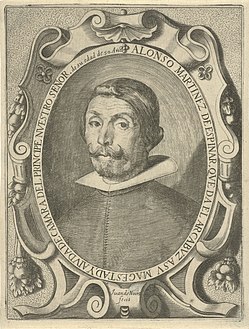Alonso Martínez de Espinar
Alonso Martínez de Espinar | |
|---|---|
 Anonymous portrait in the Museo del Greco, Toledo | |
| Born | 5 May 1588 |
| Died | 14 May 1682 (aged 94) Madrid |
| Nationality | Kingdom of Spain |
| Occupations |
|
| Notable work | Arte de ballestería y montería, 1644 |
| Spouses |
|
| Parents |
|

Alonso Martínez de Espinar (5 May 1588 – 14 May 1682) was a Spanish courtier and one of three important writers on venery of the Spanish Baroque.[1] He was a ballestero ("crossbowman") and arquebusier to several kings of Spain.[1]
Life
Martínez de Espinar was the son of Cristóbal Martínez de Espinar, of Baza in Granada, and Juana Hernández Sacristán, who was from Brunete in the province of Madrid. He was baptised in the church of San Martín in Madrid. He had a sister, Jerónima Martínez de Espinar, who married Alonso Mateos, who was ballestero to the King of Spain and the brother of Juan Mateos, author of another important book on venery.[1]
Pictorial representations
Martínez de Espinar appears in the original version of Prince Baltasar Carlos in the Riding School painted by Diego Velázquez at the Palacio del Buen Retiro in 1636.[2]: 272 He is shown in the right middle ground of the picture, handing a lance to Gaspar de Guzmán, Count-Duke of Olivares, riding-master to Prince Baltasar Carlos, who will then hand it to his charge, who is on horseback in the foreground; behind Martínez de Espinar is Juan Mateos, while on a balcony of the palace stand King Philip IV and Queen Isabel.[1][2]: 272
Three portraits are known or believed to be of Martínez de Espinar: the frontispiece of his book Arte de ballestería y montería, an engraving by Juan de Noort, also known as Johannes van Noordt III;[3] an anonymous painting of the school of Velázquez in the Museo del Prado in Madrid, thought to be of him;[1] and another anonymous portrait in the Museo del Greco in Toledo.
Published work
The Arte de ballestería y montería is one of the three principal works on venery of the Spanish Baroque period.[1][4]: 18 [a] It was published in Madrid in 1644, with a preface by Francisco de Quevedo Villegas.[1][5] It is dedicated to Balthasar Charles, Prince of Asturias, and contains portrait engravings of him and of Martínez de Espinar by Juan de Noort; the other engravings, of hunting scenes, are by an unknown hand.[1]
The book is in three parts, and – despite the title, which means roughly "the art of crossbowmanship and hunting" – deals with hunting both with the crossbow and with the arquebus; it also covers hunting with lures and traps.[1]
A second edition was published in 1739 in Naples,[6] which at that time was under Spanish rule; another was published by Antonio Marín in Madrid in 1761.[1][7]
Gallery
- Engraving by Juan van Noort from the Arte de ballesteria y monteria, 1644
- Anonymous portrait, school of Velásquez, Museo del Prado, Madrid
Notes
- ^ The others are the Origen y dignidad de la caça by Juan Mateos, 1634;[8] and the unpublished manuscript Libro de Montería by Pedro de Pedraza Gaitán.[4]: 18 [9]
References
- ^ a b c d e f g h i j José Manuel Fradejas Rueda ([2018]). Alonso Martínez de Espinar (in Spanish). Diccionario Biográfico. Madrid: Real Academia de la Historia. Accessed July 2020.
- ^ a b Enriqueta Harris (1976). Velázquez's Portrait of Prince Baltasar Carlos in the Riding School. The Burlington Magazine 118 (878): 266–275. (subscription required).
- ^ Johannes van Noordt III. London: British Museum. Archived 29 August 2020.
- ^ a b Antonio López Ontiveros (1991). Algunos aspectos de la evolución de la caza en España (in Spanish). Agricultura y Sociedad 58: 13–51.
- ^ Alonso Martínez de Espinar (1644). Arte de ballestería y montería (in Spanish). Madrid: Imprenta Real.
- ^ Alonso Martínez de Espinar (1739). Arte de ballestería y montería (in Spanish). Napoles: Por Francisco Ricciardo.
- ^ Alonso Martínez de Espinar (1761). Arte de ballestería y montería (in Spanish). Madrid: Por Antonio Marin.
- ^ Juan Mateos (1634). Origen y dignidad de la caça al exmo. sr. don Gaspar de Guzman, conde duque de San Lucar la Mayor (in Spanish). Madrid: por Fran[cis]co Martinez.
- ^ Pedro de Pedraza Gaitán ([n.d.]). Libro de montería: que trata cómo se a de seguir el monte con el arcabuz y sabuesso: dirigido a la Magestad del Rey Don Felipe Nuestro Señor IIII (in Spanish). Unpublished manuscript, in the Biblioteca Nacional de España, reference MSS/8285.


